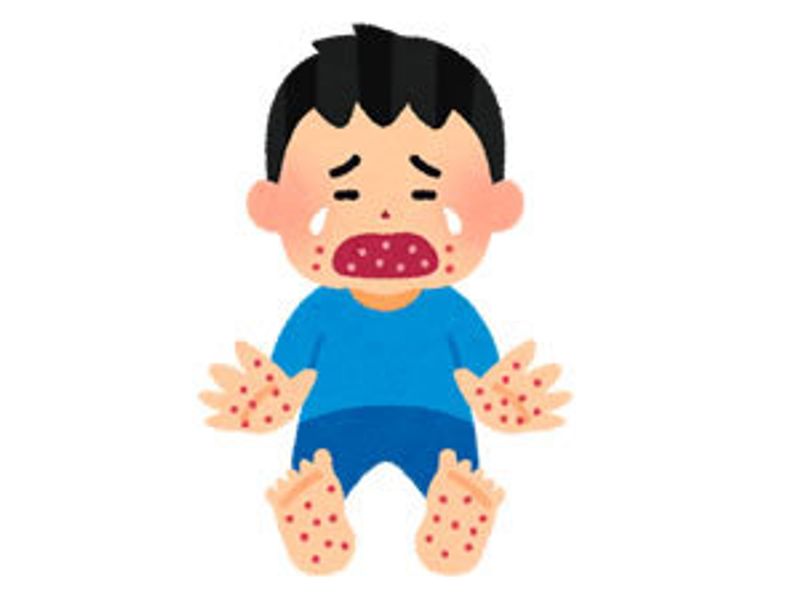Sep 3, 2019
The Horrors of Te-Ashi-Kuchi Byou
A virus that is alarmingly popular at this time of year is te-ashi-kuchi-byou, 手足口病気 or 'Hand Foot and Mouth Disease' and like it or not, it’s coming to a childcare centre, preschool or elementary school near you!

What is it?
Not to be confused with Foot-and-Mouth Disease, which can have a devastating effect on livestock, Hand, Foot and Mouth Disease is a usually minor but annoying sickness typically caused by the coxsackie family of viruses. It gets its name from the watery-looking blisters that appear several days after the victim has caught the virus. The spots appear - you guessed it! - on the hands, feet and around the mouth, and sometimes on the rear. It is most problematic when the sores appear inside the mouth, because they are painful and can affect food and water intake.
Symptoms
You won’t know you or your offspring has caught Hand-Foot-Mouth straight away, for it takes three to six days for symptoms to even appear. The first sign is often a moderate fever that can be accompanied by a general feeling of being unwell, a sore throat, loss of appetite and sometimes diarrhea. The fever tends to pass within a couple of days. It’s only one or two days after the fever has dissipated that the telltale spots actually appear. The spots can take awhile to clear up entirely and those inside the mouth and possibly on the bottom of the feet can be somewhat painful at least initially. Both my children have been lucky so far in that the spots were pretty mild; the fever stage was far more unpleasant for them.
Treatment
Like most viruses, you simply have to let it run its course. Unless dehydration is an issue from lack of water - in which case, seek medical help - there isn’t much a doctor can do beyond prescribe fever-reducing medicine. My daughter got given a choice between suppositories, and a powdered form of paracetamol (acetaminophen) that can be mixed in with juice, milk, yogurt and anything else liquid-ish but is otherwise no stronger than over-the-counter medicines. Doctors can’t even say for sure what it is until the spots appear.
The one thing the doctor is good for is issuing medical certificates - and you will need a medical certificate. Trust me, we tried to avoid yet another pointless visit to the doctor’s. Called a chiyu-sho-mae 治癒書前, the literal translation is 'certificate of healing' and it tells your education or care provider that your child is recovering well. Doctors are definitely familiar with this document and it will cost you about 500 yen. It may feel a bit pointless, given that the doctors can’t even diagnose the sickness until you’re no longer even contagious, but everyone likes to feel (and appear) as though they’re managing things even when it’s all but impossible to do so.
Contagion
Hand Foot and Mouth is highly contagious. You can catch it from other people’s body fluids (charming, yes) and it is particularly common in children under 10 years old.
At my children’s childcare, over two thirds of the baby class and one third of my daughter’s one year old class have had it. While it’s impossible for me or anyone else to say for sure, my daughter had it at around the same time as everyone else did and within about a week of them starting water play, so you can probably join the dots…
There is a bit of a question over when it is contagious. The general consensus is that it’s definitely contagious before symptoms appear, but after that it depends on what resource you check. The US CDC, for example, advises you're contagious for… well, ages, especially during the first week and then for some time afterwards. Other sources, however, advise that once the fever is gone and as long as the patient is eating and drinking well, they are fit to return to care/school/work, and it’s this ruling that a lot of education and care providers hereabouts go with.
Timeline
For both my children, the timeline has been pretty similar. My son’s bout with Hand, Foot and Mouth Disease was a couple of years ago, so I’ll just go with my 1.5 year old daughter as an example here:
Thursday
Morning: Pretty normal, a bit sleepy but nothing out of the ordinary. By mid-morning, she had developed a fever and had to be picked up from childcare early.
Afternoon: Very sad/sleepy, fever continued. No appetite, though she did drink juice and milk. Three or four rounds of diarrhea.
Evening: Slept, woke up a few times crying
Friday
Morning: Fever lower, ate some of her breakfast
Afternoon: Fever gone, appetite a bit off but eating. Behavior largely normal
Saturday
Morning: Normal
Afternoon: Woke up from her nap with some spots on her feet and hands, and most noticeably on her backside. Behaving normally
Sunday
Normal
Monday
Normal. It was a public holiday or we would have gotten the medical certificate then.
Tuesday
Normal, obtained medical certificate.
How to avoid it
While Hand, Foot and Mouth Disease is more annoying than serious, it’s still not something you’re going to want to catch. This is a compilation of advice I’ve come across:
- Wash your hands well with soap and warm water.
- Hand sanitizer works on this one.
- Practice good hygiene and keep surfaces etc. clean
- The virus can survive in water, so don’t go swimming when you have it.
- Don’t share towels.
- Avoid people with it
And…
- Hope for the best.
Good luck!
How are you going with summer viruses in your household? Have you had the pleasure of hosting Hand, Foot and Mouth Disease yourself? Do you have any tips for sufferers?



0 Comments